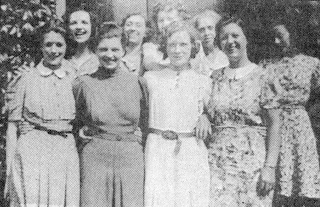
We had the pleasure of a visit from approximately 20 members of the Headland Local History group yesterday, who came to take a look around our archaeological store based in the grounds of Sir William Gray House.
The underground bunker was built in the grounds of Sir William Gray House in 1937 amid fears of the outbreak of World War 2.
The massive concrete structure, measuring 40 feet by 30 feet and buried 20 feet underground was used as a report centre from where air raid patrols and rescue activities were co-ordinated.
Hartlepool was a primary target during the war as the enemy were constantly trying to target the shipyards and steelworks.
In the early weeks of the war the air filtration system, which was installed because of the threat of gas attacks, had to be powered by bicycle until an electric motor was eventually obtained to run it.
The massive concrete structure, measuring 40 feet by 30 feet and buried 20 feet underground was used as a report centre from where air raid patrols and rescue activities were co-ordinated.
Hartlepool was a primary target during the war as the enemy were constantly trying to target the shipyards and steelworks.
In the early weeks of the war the air filtration system, which was installed because of the threat of gas attacks, had to be powered by bicycle until an electric motor was eventually obtained to run it.

During an air raid they had to take the telephone calls on one of 3 telephones in the middle room and report any casualties or damage.
Young messenger boys on bicycles took messages throughout the town. Mr Boagey who visited on a previous Heritage Open day recalls the time spent in the bunker – especially the time a bomb exploded nearby and sent him from the top of the bunker steps to the bottom.
The staff slept in the Gray Art Gallery (now called Sir William Gray House) and operated both day and night shifts, with a small team of staff always on duty in the bunker.
One night a bomb narrowly missed the bunker and landed on the nearby greyhound track killing 2 firewatchers, (Now Morrison’s Supermarket) ; with the bomb blast blowing Mr Boagey out of his bed in Sir William Gray House.
If it had been dropped a split second sooner it would have exploded directly on top of the bunker.
The bunker was sealed after the war and was eventually re-opened in 1982 when it was used as a storeroom by the workers who were rebuilding the tramshed in the grounds of Sir William Gray House.
At this time the toilets still had a blast flap on the bottom of the door which would have opened and reduced the pressure from any bomb blast.
The electrics were also improved at this time and the bunker was then sealed for a further 10 years.
In 1992 new toilets and sinks were installed for use by
School groups as the bunker was converted into an education centre.
The bunker originally had a steel sub-frame which was removed in 1996 to increase floor space.
The bunker is now used as the archaeology store for Tees Archaeology.
The staff slept in the Gray Art Gallery (now called Sir William Gray House) and operated both day and night shifts, with a small team of staff always on duty in the bunker.
One night a bomb narrowly missed the bunker and landed on the nearby greyhound track killing 2 firewatchers, (Now Morrison’s Supermarket) ; with the bomb blast blowing Mr Boagey out of his bed in Sir William Gray House.
If it had been dropped a split second sooner it would have exploded directly on top of the bunker.
The bunker was sealed after the war and was eventually re-opened in 1982 when it was used as a storeroom by the workers who were rebuilding the tramshed in the grounds of Sir William Gray House.
At this time the toilets still had a blast flap on the bottom of the door which would have opened and reduced the pressure from any bomb blast.
The electrics were also improved at this time and the bunker was then sealed for a further 10 years.
In 1992 new toilets and sinks were installed for use by
School groups as the bunker was converted into an education centre.
The bunker originally had a steel sub-frame which was removed in 1996 to increase floor space.
The bunker is now used as the archaeology store for Tees Archaeology.


No comments:
Post a Comment